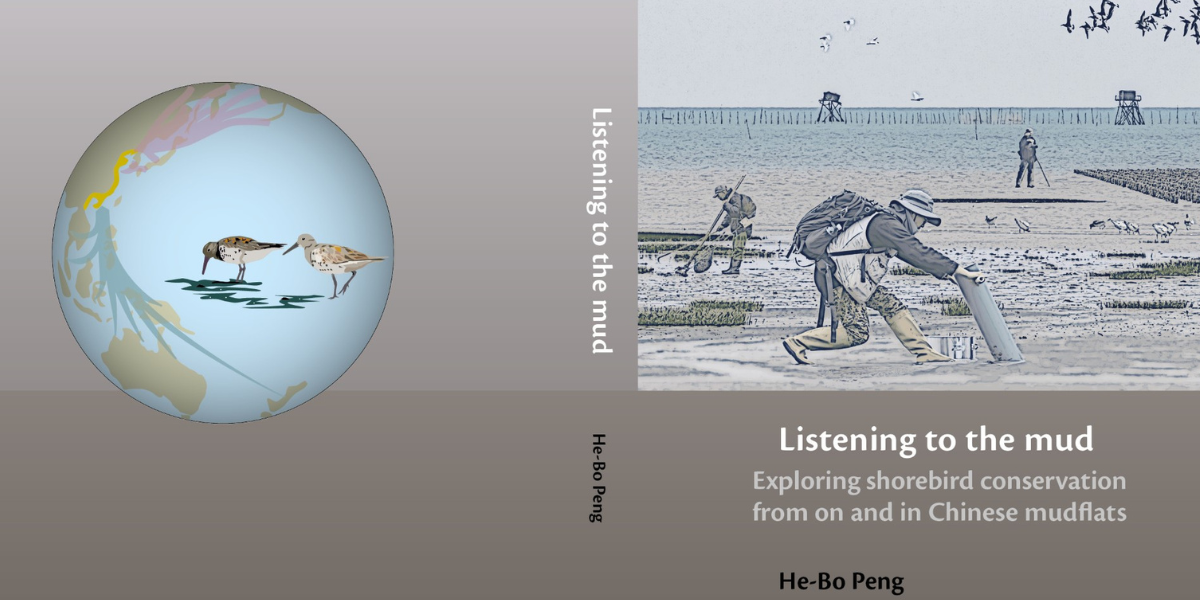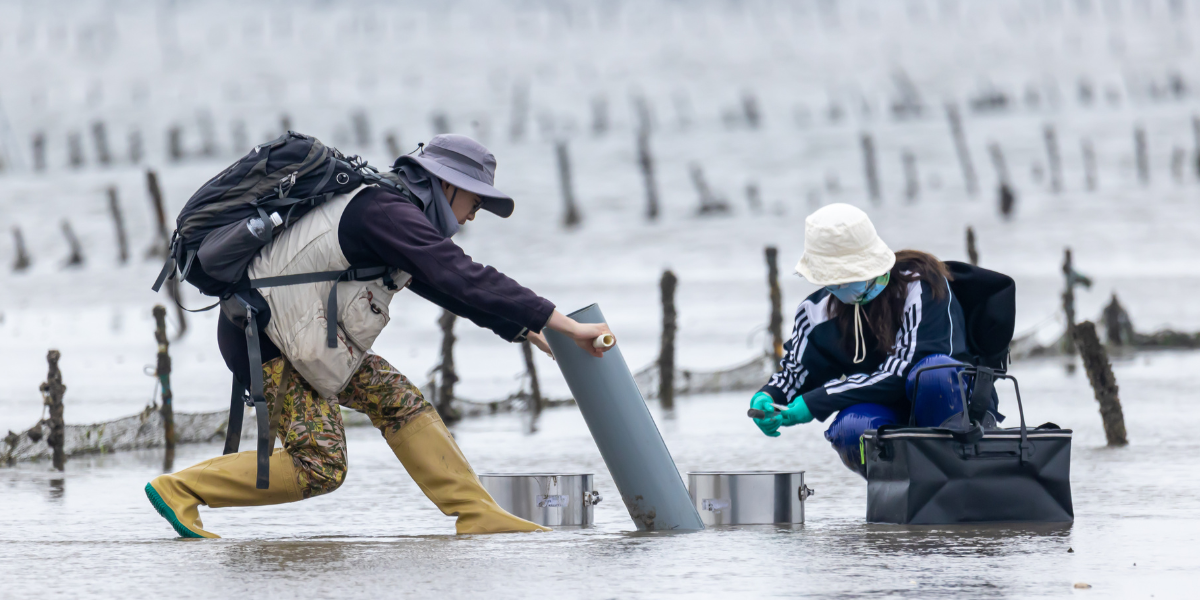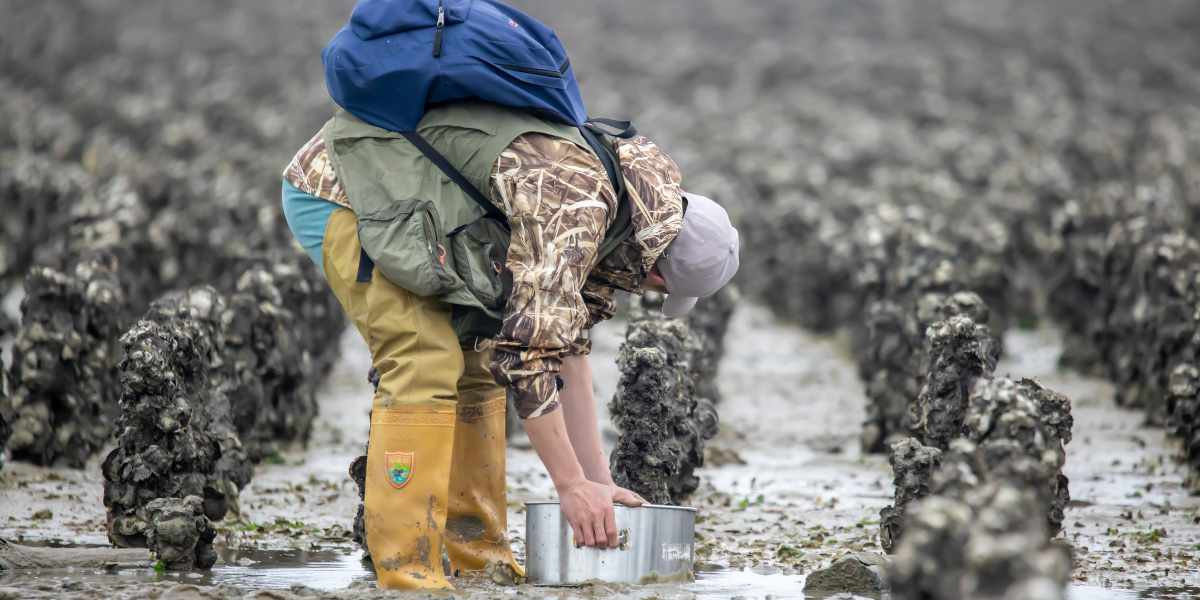Aquaculture blessing in disguise for migratory waders fueling up in China

~ For Dutch, scroll down ~
Long term monitoring
Peng was the first to design a systematic survey of large parts of the intertidal mudflats along the 18.000 km of the Chinese coast. Between 2015 and 2023, he and his colleagues sampled 2,000 points on 40 different locations on a yearly basis, analyzing soil properties as well as living organisms that were found in the mud. The sampling was designed after the SIBES-program, that has been running as of 2008 on a grid with 5.000 locations in the Dutch Wadden Sea. “The work of Peng was one of the first that ‘exported’ our SIBES-design to international waters”, the scientific coordinator of this monitoring program, NIOZ biologist Allert Bijleveld says. “We are thrilled to see this long-term program copied to other important nature areas around the world.”
Shellfish culture
“My main finding was that the majority of the ‘bird food’ that we found in the mud was linked to the culturing of shellfish”, Peng says. “Overall, the number of waders like the great and the red knot are in decline along the Chinese coast, but at least on the locations where shellfish like Potamocorbula laevis were cultured in an extensive way, without pesticides and protective nets, the red knots as well as curlew sandpipers were doing relatively well. You can, therefore, say this aquaculture is a blessing in disguise for the migratory birds that depend on these ecosystems.”

Reclaiming land
The coast of the Yellow Sea has a long history of land reclamation for housing and industry. This reclaiming of land has stopped on most locations and there is even a modest increase in surface of mud flats on some parts. Peng: “On the locations where aquaculture has stopped as well, we see an almost unlimited exploitation of the mud flats by the local community. Therefore, the controlled management in aquaculture is a relatively good way to preserve at least some of the natural qualities of the intertidal flats.”
Listen to the mud
In his dissertation, Peng advices to ‘listen to the mud’. “This work is just a modest start of our understanding of these very important staging areas for birds on migration between eastern Siberia and Oceania. Through continuation of the long-term monitoring of the mud flats, as well as through tracking of birds with high tech transmitters, we can learn so much more in our quest for understanding of these ecosystems”, Peng says.

Daunting task
Professor in global flyway ecology Theunis Piersma stresses the importance of the work of his PhD-candidate. “Peng has shown that along the entire 18.000 km of the coastline, from the temperate climate in the north to the tropical parts in the south, biodiversity has homogenized under the influence of aquaculture. Given the intense use by local communities, returning these mudflats to true natural ecosystems will be a daunting task . But the incredible amount of work that Peng has done – and hopefully will continue to do – to monitor these ecosystems, will at least help us guide that process, should China chose to protect both the international travelling birds as well as the benthic biodiversity.”

Aquacultuur verkapte zegen voor Chinese steltlopers
Op de wadplaten langs de Chinese kust waar een niet-destructieve vorm van aquacultuur wordt bedreven, gaat het nog relatief goed met kustvogels als kanoeten en rosse grutto’s. Dat blijkt uit het proefschrift dat NIOZ PhD kandidaat en bioloog He-Bo Peng op 15 januari aan de Rijksuniversiteit Groningen verdedigt. "Het kweken van schelpdieren moet je zeker niet zien als ‘natuurbescherming’, maar het houdt in ieder geval het wad in China en het vogelvoer in een betere conditie dan zónder deze aquacultuur", aldus Peng.
Lange termijn monitoring
Peng was de eerste die een systematisch onderzoek opzette op grote delen van het wad langs de 18.000 km lange Chinese kust. Tussen 2015 en 2023 bemonsterden hij en zijn collega's jaarlijks 2.000 punten op 40 verschillende locaties, waarbij ze zowel de bodemeigenschappen als de levende organismen die in het slik werden aangetroffen analyseerden. De bemonstering is opgezet naar het voorbeeld van het SIBES-programma, dat sinds 2008 een netwerk van 5.000 locaties in de Nederlandse Waddenzee bemonstert. "Peng was een van de eersten die ons SIBES-ontwerp 'exporteerde' naar internationale wateren", zegt de wetenschappelijk coördinator van dit monitoringsprogramma, NIOZ-bioloog Allert Bijleveld. "We vinden het geweldig om te zien dat het langetermijnprogramma SIBES navolging krijgt in andere belangrijke natuurgebieden over de hele wereld."
Schelpdiercultuur
"Mijn belangrijkste bevinding was dat het grootste deel van het 'vogelvoedsel' dat we in de wadbodem vonden, samenhing met de kweek van schelpdieren", zegt Peng."Over het algemeen neemt het aantal steltlopers zoals kanoeten langs de Chinese kust af, maar op de locaties waar schelpdieren als Potamocorbula laevis op grote schaal worden gekweekt, zonder pesticiden en beschermende netten, deden zowel de kanoet als de krombekstrandloper het relatief goed. Je kunt dus zeggen dat deze aquacultuur een verkapte zegen is voor de trekvogels die afhankelijk zijn van deze ecosystemen."
Inpolderen
De Chinese kust kent een lange geschiedenis van inpoldering van wadplaten, bijvoorbeeld in de Gele Zee, voor woningbouw en industrie. Deze landaanwinning is op de meeste locaties inmiddels gestopt en op sommige plekken is zelfs sprake van een bescheiden toename van het wadoppervlak. Peng: "Op de locaties waar ook de aquacultuur is gestopt, zien we nu een bijna ongeremde exploitatie van het wad door de lokale bevolking. Daarom is gecontroleerd beheer in de vorm van aquacultuur een relatief goede manier om tenminste een deel van de natuurlijke kwaliteiten van het wad te behouden."
Luister naar de modder
In zijn proefschrift adviseert Peng om 'naar de modder te luisteren'. "Dit werk is slechts een bescheiden begin om deze belangrijke pleisterplaatsen voor vogels op trek tussen Oost-Siberië en Oceanië te begrijpen. Door het wad langdurig te bemonsteren en door ook vogels te volgen met hightech zenders, kunnen we nog veel meer leren over deze ecosystemen", aldus Peng.
Uitdaging
Hoogleraar trekvogelecolgie Theunis Piersma benadrukt het belang van het werk van zijn promovendus. "Peng heeft aangetoond dat langs de gehele 18.000 km lange kustlijn, van het gematigde klimaat in het noorden tot de tropische delen in het zuiden, de biodiversiteit is gehomogeniseerd onder invloed van aquacultuur. Gezien het intensieve gebruik door de lokale gemeenschappen zal het een enorme opgave zijn om deze wadplaten terug te brengen tot echte natuurlijke ecosystemen. Maar de ongelooflijke hoeveelheid werk die Peng heeft verzet - en hopelijk zal blijven verzetten - om deze ecosystemen te monitoren, zal ons op zijn minst helpen om dat proces te begeleiden, mocht China ervoor kiezen om zowel de trekvogels als het bodemleven op de wadplaten te beschermen."
PhD defence
Time & date: 09:00, 15 January 2024
Location: Academy building RUG
